Discovery, Structure-Activity Relationships, and In Vivo Evaluation of Novel Aryl Amides as Brain Penetrant Adaptor Protein 2-Associated Kinase 1 (AAK1) Inhibitors for the Treatment of Neuropathic Pain.
Hartz, R.A., Ahuja, V.T., Nara, S.J., Kumar, C.M.V., Brown, J.M., Bristow, L.J., Rajamani, R., Muckelbauer, J.K., Camac, D., Kiefer, S.E., Hunihan, L., Gulianello, M., Lewis, M., Easton, A., Lippy, J.S., Surti, N., Pattipati, S.N., Dokania, M., Elavazhagan, S., Dandapani, K., Hamman, B.D., Allen, J., Kostich, W., Bronson, J.J., Macor, J.E., Dzierba, C.D.(2021) J Med Chem 64: 11090-11128
- PubMed: 34270254
- DOI: https://doi.org/10.1021/acs.jmedchem.1c00472
- Primary Citation of Related Structures:
7LVH, 7LVI - PubMed Abstract:
Effective treatment of chronic pain, in particular neuropathic pain, without the side effects that often accompany currently available treatment options is an area of significant unmet medical need. A phenotypic screen of mouse gene knockouts led to the discovery that adaptor protein 2-associated kinase 1 (AAK1) is a potential therapeutic target for neuropathic pain. The synthesis and optimization of structure-activity relationships of a series of aryl amide-based AAK1 inhibitors led to the identification of 59 , a brain penetrant, AAK1-selective inhibitor that proved to be a valuable tool compound. Compound 59 was evaluated in mice for the inhibition of μ2 phosphorylation. Studies conducted with 59 in pain models demonstrated that this compound was efficacious in the phase II formalin model for persistent pain and the chronic-constriction-injury-induced model for neuropathic pain in rats. These results suggest that AAK1 inhibition is a promising approach for the treatment of neuropathic pain.
- Department of Small Molecule Drug Discovery, Bristol Myers Squibb Company, Research and Development, Wallingford, Connecticut 06492, United States.
Organizational Affiliation:



















